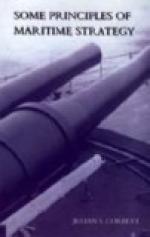When the preponderating Power fails or neglects to get command (i.e., leaves the general command in dispute), the disadvantage to him is not so much the danger to his own operations as the facility given to the enemy for carrying out counter operations elsewhere.
METHODS OF SECURING CONTROL.
1. Permanent general control can only be secured by the practical annihilation of the enemy’s fleet by successful actions.
2. Local and temporary control may be secured by—
(a) An action not necessarily entirely successful (containing).
(b) Inducing concentration on the enemy elsewhere (diversion).
(c) Superior concentration
so as to render impotent the enemy’s force
available in the special theatre
of operations (masking or containing).
(d) Blockade.
Action of a Fleet off an Enemy’s Port
A belligerent fleet off an enemy’s port may carry out three different operations, for certain purposes; each quite separate from the others, and intended to obtain an entirely different result:—
(1) Close Blockade.—This is to prevent the enemy’s fighting ships from putting to sea. In this case the object is to secure local control for some purpose that is not purely naval, such as was carried out by the Japanese off Port Arthur in 1904, so as to enable their transports to cross the Yellow Sea without fear of molestation from any of the Russian ships in Port Arthur. Since the cruisers in Vladivostok were able to emerge (that port not being blockaded), the operation was not complete, and a danger of interference always existed.
This method of blockade is far more difficult to carry out in the present day, than formerly; owing to the existence of submarines and torpedo craft, the blockading ships have to remain further away from the port; there have to be inner lines of cruisers, scouts and destroyers; and quick concentration takes longer owing to the greater space covered by the blockading force, and more ships of all natures are required for the same reason.
Greater and more vigilance are required than in former days, because the enemy’s ships can come out regardless of weather (thick weather would be their opportunity), and it is most important that not a single craft, from a battleship to a torpedo boat, be allowed to escape.
This method of blockade includes the commercial blockade, and all countries would be informed of its having been established.
(2) Commercial Blockade.—To prevent floating commerce from entering or leaving the blockaded harbour. The blockading force would not be powerful enough to prevent a squadron of battleships or cruisers from entering or leaving the port blockaded; and it would not be instituted outside a fortified military port, or one containing a strong naval force. But it would be able to stop scouts and torpedo craft from entering or emerging, unless in very great numbers; and if unable to stop them from emerging, would give warning of their escape and the direction in which they are going.




